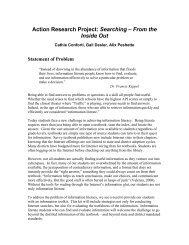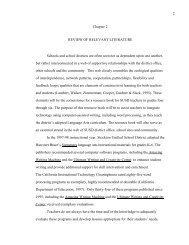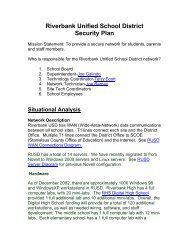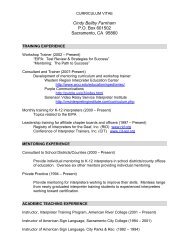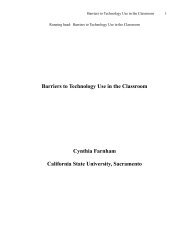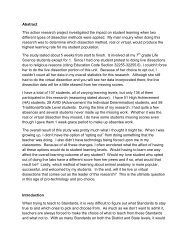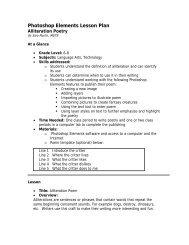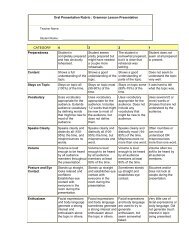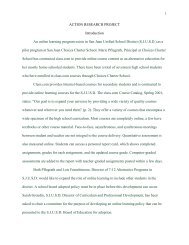Qualitative Research - iMET
Qualitative Research - iMET
Qualitative Research - iMET
Create successful ePaper yourself
Turn your PDF publications into a flip-book with our unique Google optimized e-Paper software.
<strong>Qualitative</strong> <strong>Research</strong>http://qrj.sagepub.comAvatar watching: participant observation in graphical onlineenvironmentsMatthew Williams<strong>Qualitative</strong> <strong>Research</strong> 2007; 7; 5DOI: 10.1177/1468794107071408The online version of this article can be found at:http://qrj.sagepub.com/cgi/content/abstract/7/1/5Published by:http://www.sagepublications.comAdditional services and information for <strong>Qualitative</strong> <strong>Research</strong> can be found at:Email Alerts: http://qrj.sagepub.com/cgi/alertsSubscriptions: http://qrj.sagepub.com/subscriptionsReprints: http://www.sagepub.com/journalsReprints.navPermissions: http://www.sagepub.com/journalsPermissions.navCitations (this article cites 7 articles hosted on theSAGE Journals Online and HighWire Press platforms):http://qrj.sagepub.com/cgi/content/refs/7/1/5Downloaded from http://qrj.sagepub.com at CAL STATE UNIV SACRAMENTO on August 31, 2007© 2007 SAGE Publications. All rights reserved. Not for commercial use or unauthorized distribution.
ARTICLE 5Avatar watching: participant observation ingraphical online environmentsQRMATTHEW WILLIAMSSchool of Social Sciences, Cardiff University<strong>Qualitative</strong> <strong>Research</strong>Copyright © 2007SAGE Publications(London,Thousand Oaksand New Delhivol. 7(1) 5–24ABSTRACT Increasingly, social science researchers are turning to theinternet to study forms of ‘virtual’ culture. In tandem there has been adegree of trepidation and innovation in the application of researchmethodology to the online arena. As its focus this article takes theapplication of participant observation to the virtual field. Drawing uponnarratives elicited from community members of an online graphicalsocial space, methodological questions are raised about the viability of a‘virtual ethnography’, while a more practical discussion focuses upon there-engineering of participant observation for operation in an onlinepseudo-physical field. The impact of graphical pseudo-presence, avatarrepresentation, physical online boundaries and multiple online sites uponthe practice of participant observation are examined. The articleconcludes that the advent of new broadband technologies and theexpansion of graphical online environments require online methods thatare both responsive and adaptive in order to elicit reliable and valid datafrom rapidly changing online environments.KEYWORDS: avatars, internet, online research, participant observation, virtualethnographyIntroductionSocial scientists are increasingly recognizing the possibilities of using the internetand associated technologies for research purposes. Numerous articles andedited collections detail the complexities and issues relating to the re-engineeringof offline social science research methodologies for use in online environments(see Johns et al., 2004; Jones, 1995, 1997, 1998, 1999; Mann and Stewart,2000). However, less specific work has been done on issues relating to the use ofethnographic participant observation online. While some scholars have appliedand written about participant observation in textual online environments(see Hine, 2000; Leander and Mckim, 2003; Markham, 1998) there is a paucityof work on the application of the method to graphical online environments.DOI: 10.1177/1468794107071408Downloaded from http://qrj.sagepub.com at CAL STATE UNIV SACRAMENTO on August 31, 2007© 2007 SAGE Publications. All rights reserved. Not for commercial use or unauthorized distribution.
Williams: Avatar watching7examine decision-making processes via CMC, which in turn established theinfluential ‘reduced social cues’ model (Kiesler et al., 1984; Sproull and Kiesler,1991). It was suggested that the text-based medium of email removed socialcontext cues such as gender, age, race, social status, facial expression and intonationresulting in a disinhibiting effect upon group participants. While thisposition came under criticism from other psychologists (see Lea and Spears,1991; Spears et al., 1990), the most significant shift in CMC research emergedfrom within other disciplines. Rheingold (1993) was particularly influential inestablishing the view that beyond experimental settings individuals werechoosing to use CMC for social interaction on a daily basis. The notion of the‘virtual community’ developed from this insight, a concept that has seen muchdebate over subsequent years. Debates about the existence of social networksonline, their significance in respect to those who frequent virtual spaces andsimilar symbolic and cultural enquiries ensured that certain forms of CMCbecame recognized as new sites of investigation for social scientists. Whereasthe psychologists were applying their statistical tests to what became dubbedas ‘online behaviour’, unsurprisingly the trend in sociology was to look uponCMC, and its myriad incarnations, as an extension of everyday life.Such a bifurcation in approach to the CMC setting clearly derives, in part,from the way in which both researchers and users conceptualize the technology.As Markham (1998) notes, certain users simply describe this technologyas a conduit that transmits information from one place to another treating theinternet as a tool, whereas others express the physical locality of cyberspace(although there is no true physical space), regarding it as a place to meet andinteract with likeminded people. Other seasoned users conceptualize CMC as away of being, emphasizing how they and others are able to express self throughtext, talking of experiences in or as the text. Early experimental researcherstended to view CMC as a tool, as did many in Markham’s study, testing andutilizing the arena as a mode of communication no different from the telephone.In contrast, those interested in cultural and symbolic formations conceptualizedCMC as a place or site of investigation, where new ways of beingthrough text and other mediums could be explored. <strong>Research</strong>ers are now comingto view CMC not only as a cultural sphere in itself, but also as a culturalartefact, a set of objects that have become imbued with symbolic meaningfrom the initial stage of the technology’s production to the outcome – its consumptionand modes of usage (Hine, 2000).The epistemological shift in focus from viewing CMC as an alternativemethod of communication to the birth of a new cultural formation has alsoseen the emergence of a methodological debate surrounding new ways ofinvestigating online cultural phenomena. Unquestionably, when setting out todo research in these new cultural dimensions, researchers are faced with a set ofquestions about whether existing research methods still apply. While CMC settingsare in some respects significantly different from other forms of social interactionthat preceded the technology of the internet, this does not repudiate theDownloaded from http://qrj.sagepub.com at CAL STATE UNIV SACRAMENTO on August 31, 2007© 2007 SAGE Publications. All rights reserved. Not for commercial use or unauthorized distribution.
8<strong>Qualitative</strong> <strong>Research</strong> 7(1)significance or applicability of offline social science methods to such settings.However, in light of boundless research populations, anonymous informantsand multiple field sites, these methods must be adapted. As a result, an opportunityis opened up for researchers to take reflexive accounts of their researchprocess in a new and unfamiliar social arena. The remainder of this articleseeks to elucidate the above position, initially highlighting some epistemologicalquagmires relating to conducting ethnography online.Virtual ethnographyWhen one begins to ask if an ethnographic account is a true reflection of theculture, place or people it claims to have studied, issues of naturalism and realismcollide with constructivist notions that reconceptualize ethnographicauthenticity. It is here, a place shadowed in doubt over the ethnographer’s abilityto ‘tell it the way it is’, where several have remarked in defence that ethnographicwriting is not a transparent representation of culture, nor should it be(Clifford and Marcus, 1986). Ethnographers construct the ‘reality’ of a socialsetting through direct and indirect experience and are influenced by the toolsthey use, which in turn reflects upon their writings on the objects of study. Inthis sense ethnographies are ‘textual constructions of reality’ (Atkinson, 1990)that are a product in part of a story-telling institution (Van Maanen, 1995).Questions based on the authority and authenticity of ethnographic accountsthen lay at rest – at least in part – in the face of methodological reflexivity. It isthis element of reflexivity – ‘that the orientations of the researchers will beshaped by their socio-historical locations, including the values and intereststhat these locations confer upon them’ (Hammersley and Atkinson, 1995: 16) –that requires the ethnographer to reflect upon participant observation, access,experience in the field and beyond. While reflexivity allows researchers to produce‘open’ accounts in the ‘real’ or offline world, recent concerns have beencast on the reproduction of similarly grounded accounts in the virtual arena.Epistemological and methodological questions complicate the application ofmethods to the online setting: to what extent is the researcher able to write ina convincing way about the people studied when anonymity inherent in internetinteractions casts doubts upon the identities of research participants? 2How does the participant observer manage their identity in settings mediatedby text and graphics, and what impact might this have on data collection? Howare researchers to conceptualize the boundaries of online settings and theexperiences of those observed?An adaptive form of ethnography is required in the face of the complexitiesposed by online settings. This virtual ethnography would utilize the environmentit is faced with (Hine, 2000). It would make use of the myriad technologiesit is presented with in an attempt to further explore the medium, and totranscend possible methodological barriers. What form these technologiesDownloaded from http://qrj.sagepub.com at CAL STATE UNIV SACRAMENTO on August 31, 2007© 2007 SAGE Publications. All rights reserved. Not for commercial use or unauthorized distribution.
Williams: Avatar watching9and barriers take is specific to the object of study. The remainder of this articleprovides an extended empirical example of one element of a virtual ethnographyconducted in a graphical online setting in an attempt to answer some ofthe questions previously posed. Data elicited from ethnographic online discussionswith participants 3 show how the characteristics of graphical environmentspose unique issues for participant observation that are distinct fromthose posed by text-only and traditional offline settings.THE SETTING(S)Previous qualitative internet research has been conducted in numerous settings(for examples, see Baym, 1995a, 1995b, 1998; Correll, 1995; Denzin,1999; Markham, 1998; Paccagnella, 1997; Turkle, 1995). Notable studiesfeature alcoholic dependency groups (Denzin, 1999), a virtual lesbian café(Correll, 1995) and a virtual university (Markham, 1998) to name a few. BothBaym (1995a, 1995b, 1998) and Correll (1995) conducted what they consideredan ethnography of participants’ use of the internet by following themthrough real-time discussions to email exchanges and face-to-face interviews.Both researchers claimed to have studied and represented their participants’‘enduring practices’ through which their online community became meaningful.These various sites – newsgroups, Internet Relay Chat (IRC), Multi-UserDomains (MUDs) and many other technologies of mediation – have pushedforward the boundaries of online communication to a pivotal, and arguablyexciting, point where works of fiction are becoming mirrored by reality. Mostnotably, the advent of graphical or visual communication via broadband internettechnologies has heralded the first low budget in-home virtual reality experience.Incorporating the synchronous textual experience of IRC and MUDs,virtual reality environments take advantage of improved hardware by incorporating3D (sometimes 2D) computer-generated space viewed on a standardcomputer monitor. The key characteristic to the dozen or so graphical communitiescurrently housing over a million internet enthusiasts is their abilityto represent users as figures or characters called avatars 4 (see Figure 1).Avatars draw users to perceive their body as manifested in a cybernetic plane,through digital representations that are more or less models of their desired orfantasized appearance and behaviour. It is this visual representation of thecomputer user in virtual space that creates a new dimension of communicationwithin online communities. Forms of interaction need no longer berestricted to text (although novel forms of textual communication such asnetiquette expand expressive capacity), as both proxemical and kinesical featuresin everyday communication can be replicated in avatar form. Socialinteraction becomes more complex, with the combination of the textual utteranceand the corresponding avatar gesture. Beyond communication, graphicalcommunities also enable the user to visually explore the landscape, aprocess that was until recently only imagined within text-based environments.Downloaded from http://qrj.sagepub.com at CAL STATE UNIV SACRAMENTO on August 31, 2007© 2007 SAGE Publications. All rights reserved. Not for commercial use or unauthorized distribution.
10<strong>Qualitative</strong> <strong>Research</strong> 7(1)F IGURE1. A typical avatarThe ability to wander around a virtual environment led many programmersto incorporate a building option in some graphical communities. One suchcommunity named Cyberworlds is heralded as one of the pioneers in this field,boasting thousands of private and public built spaces. Citizens have the right tobuild on any plot of land, and are encouraged to attend virtual classes onbuilding techniques. Pride is taken in building within this environment, in somuch as it reflects and strengthens community cohesion. Walking alongcrowded virtual streets, wandering into virtual cemeteries and interactingwith avatars in a myriad of contexts is at first disorientating not only for visitorsbut also for the virtual ethnographer.Participant observation was utilized to gather detailed field-notes on online lifewithin this graphical environment. The complementary method of online focusgroup interviewing was employed to elicit detailed narratives from citizens andtourists. 5 Unlike online participant observation, this method was exercised asynchronouslyvia a discussion list (group email) over a six-month period. The textualdata obtained from the online focus group are presented as illustrativeexamples of the complexities of conducting participant observation in the onlinegraphical field.Participant observation in graphical online environmentsThe work of Markham (1998), Hine (2000) and Leander and Mckim (2003),among others, has addressed the application and adaptation of participant observationto the online environment. Primarily this work relates to the observation oftextual exchanges, both synchronous and asynchronous, within MUDs, MOOs,Downloaded from http://qrj.sagepub.com at CAL STATE UNIV SACRAMENTO on August 31, 2007© 2007 SAGE Publications. All rights reserved. Not for commercial use or unauthorized distribution.
Williams: Avatar watching11newsgroups, discussion lists and IRC. From engaging in the practice of participantobservation in these disparate online spaces, these authors were able to raiseimportant methodological and epistemological questions. These ranged from thedifficulties associated with analysing discourse in textual spaces where lurkers areabundant (Hine, 2000) to epistemological concerns over the role of the observerin online settings (Leander and Mckim, 2003). Given the recent popularity ofgraphical online social spaces, it is becoming increasingly pressing to determine ifthe methodological issues previously raised pertain to environments that broadenthe bandwidth of communication beyond text.GRAPHICAL PSEUDO-PRESENCE AND ONLINE INTERACTIVITYThe preoccupation with physical geography has been a stumbling block formany when attempting to conceptualize a community mediated by computernetworks (Lajoie, 1996; Mnookin, 1996; Nguyen and Alexander, 1996). Withan absence of physicality, a lack of face-to-face communication and presence, itis no wonder many critics reject the notion that community can be sustainedonline (Kolko and Reid, 1998). The social immersion, realism and ‘shared space’that presence creates are arguably lost in a digital medium (Lombard and Ditton,1997). Herring (1999) has argued that the incoherence in interaction experiencedby many users of text-only CMC, resulting from disrupted adjacency, overlappingexchanges and topic delay, must have a negative effect on communitycohesion. In response, researchers have taken on board the task of understandinghow social formations are sustained within spaces devoid of physicality.Markham (1998: 86) identified a group of internet users who consideredcyberspace as a place where ‘they can go and meet and talk with others’.Markham continues to recall the experiences of her research participants,claiming that ‘although such online worlds may not have a physical substance,they are thought of as meaningful places where things happen thathave genuine consequences. Some users talk about these online spaces as virtualcommunities. Others call cyberspace “home”’. Markham’s study featuredtext-only online environments, such as chat rooms and MUDs, where any simulacrumof presence had to be imagined by the user. The technology becomesa mode of being, where individuals become the text they write. This can beseen in individualized styles of writing and the use of emoticons. Regulars tothe online community begin to recognize others by expressive style and content;personality is imbued within the text written onscreen, creating a pseudo-presence.Herring (1999: 20) concludes in her paper that the ‘messy texts’ experiencedwithin social interaction online can intensify interactivity, often extending ‘thelimits of what is possible in spoken conversation’.The lack of face-to-face and ‘physical’ interaction in text-based CMC meansthat presence is imagined. The descriptions of spaces in MUDs and MOOs evokevivid imagery in the user’s imagination:Welcome to Diversity University! Ambient lighting conveys a calm and friendlyatmosphere, and there is always plenty of space on the red couches here. ThisDownloaded from http://qrj.sagepub.com at CAL STATE UNIV SACRAMENTO on August 31, 2007© 2007 SAGE Publications. All rights reserved. Not for commercial use or unauthorized distribution.
12<strong>Qualitative</strong> <strong>Research</strong> 7(1)centre is located in the Student Union, so when you feel ready to explore, just leavefor the foyer by typing OUT.Type HELP NEWBIE for a quick summary of commands.Exits include: [west] to the Quiet Cubicles, [out] to the Student Union Foyer, [tutorial]to Tutorial Center, [north] to Help Desk (not just for newbies), [southeast] toTour Centre.You are standing here.You see Mr. Besenstiel, a large banner, an application folder and a map here.You listen up to make out the words of an announcement, ‘Attention Guests! Tofind out how you can apply for a regular character at Diversity University MOO,Type HELP @REQUEST’. (Extract from Markham, 1998: 38)The use of vivid description and positioning (‘You are standing here’) createsa sense of presence. Similar methods are used in fantasy gaming and role-playing(Fine, 1983), and arguably some readers place themselves within novels,imagining they are part of the scene (McLaughlin, 2000). Even the mundanedescriptive language of the internet, with deliberate references such as homepagesand chatrooms, evokes physicality (Robson, 1998). The preoccupationwith presence in many social practices indicates its importance to social interactivity.Presence has been captured within graphical online environments,such as Cyberworlds, where spaces do not have to be imagined by the user;buildings, parks, malleable objects and other community members are representedby computer graphics. Within these social spaces memories can beimbued within objects, creating a sense of visual history.PRESENCE, SOCIAL IMMERSION ANDETHNOGRAPHIC OBSERVATIONGraphical pseudo-presence within Cyberworlds presents the ethnographicobserver with a unique set of difficulties and opportunities not found in textbasedenvironments. Most importantly, the pseudo-presence experiencedwithin the environment can be said to provide a more immersed interactionthan is found in text-only environments. Respondents’ narratives show howthe use of avatars enrich the communicative process. While avatar positioning,appearance and performance combine to create online identity, they alsoprovide distinct opportunities and difficulties for online observation:Kid606:IDM:it can be helpful to actually be standing next to them and talkingwith them but this is the next best thing. With avatar representationyou can just chat away still standing next to them.There are tremendous advantages to 3D Chat. You have more accessto other communication and expression. You can become an avatar,you can use music, build, all in all a fuller experience than text-basedcommunication.Downloaded from http://qrj.sagepub.com at CAL STATE UNIV SACRAMENTO on August 31, 2007© 2007 SAGE Publications. All rights reserved. Not for commercial use or unauthorized distribution.
Williams: Avatar watching13Croft:I think there is more of a presence in the 3D environment. Pure textbased feels very distant to me.The simulation of corporeal immediacy within online environments requiresthe digital ethnographer to adapt observational styles developed for text-onlyenvironments. Interactions within graphical online environments are shaped,in part, by the technology of mediation. Avatar visual representation,demeanour and the surrounding environment are all dependent and restrictedby the architecture or code of Cyberworlds. An online ethnographic observermust work within these restrictions as would an observer work with physicalrestrictions in an offline setting. Yet obstacles and opportunities presented bythe architecture of Cyberworlds are distinct enough from offline settings towarrant further explication.BEYOND TEXT: REPRESENTATION THROUGH AVATARSSimilar to text-only environments, the online participant observer must gothrough an ‘immigration’ process before entering the online space under study.Entering Cyberworlds involved the donning of an online persona that wouldexplicitly communicate a wealth of information upon the observer’s onlineidentity. The choice of pseudonym for the day and the dress and stature of theavatar chosen impact on how the observed react to the observer:Jonny_G:Pappa_m:My chosen avatar represents myself and I have found that if I visita world where my personal avatar is not available, I feel uncomfortable.I very often use the emote animations.Those who choose large avs to look tough are generally weak feelingabout themselves. The women who pick the sexiest avs are usuallythose who feel they are fat or ugly. Those who pick nice orconservative avs usually ARE nice or conservative in their behaviour.I see their choices as either a ‘front face’ or a ‘real face’ ... dependingon which they choose to present.A careful reading of the narratives reveals that physical appearance withinCyberworlds is regarded with more importance than within text-only onlineenvironments. This is not to say that the participant observer’s identity is notactively constructed within text-based mediums. Markham’s work (1998,2004, 2005) in text-based mediums shows that participants must learn to beembodied within cyberspace in order to participate. Yet, textual identities aresubject to and reliant upon the reader’s ability to maintain an image of thatidentity once the description scrolls off screen, and the possessor’s ability tomaintain identity within text. Within Cyberworlds, interlocutors are constantlyinvited to gaze upon intricately designed avatars. The part of onlineidentity that is constituted via the appearance of avatars is arguably moreapparent and intact than online identities that are reliant on text. Presumablythis is more to do with a preoccupation with the visual than the failings of text.Downloaded from http://qrj.sagepub.com at CAL STATE UNIV SACRAMENTO on August 31, 2007© 2007 SAGE Publications. All rights reserved. Not for commercial use or unauthorized distribution.
14<strong>Qualitative</strong> <strong>Research</strong> 7(1)The participant observer’s choice of avatar is then potentially more onerousthan choosing an online persona within a text-only environment. In the case ofCyberworlds choosing a tourist avatar (identified by a generic fixed appearance)over a citizen avatar (which can alter appearance) significantly impacted uponhow the observed would respond to the observer. Donning the tourist avatarallowed the observer to pose as the ‘incompetent newbie’. The combination ofvisual and textual incompetence was helpful in creating an impression ofnaiveté and humility in order to elicit data that may have seemed obvious tothose ‘local’ to the field (Fielding, 1993). Conversely there were advantages totaking on the role of the citizen. Unlike tourists, citizens paid their dues to thecommunity in the form of a monthly fee. Payment of this fee bestowed a rangeof rights and freedoms, including the ability to change the visual appearance ofone’s avatar, an increased ability to communicate with avatar gestures and theright to own land and build within Cyberworlds. This rise in status and increasein the bandwidth of communication made the participant observer privy toinformation otherwise unobtainable to tourist avatars.The importance of visual representation in online participant observation isunique to graphical environments. Within text-only environments those beingobserved often have to textually encounter the observer before being able tomake a judgement (forgoing the limited judgement based on online pseudonym).Within Cyberworlds the constant visual reminder of avatar status means thatthose being observed can make rapid judgements about the observer without theneed for textual communication.This permanent ‘physical’ representation negates Hine’s (2000) concernover the practicality of conducting participant observation online. The presenceof lurkers (watchers of online interaction as opposed to contributors) in textbasedsettings makes it difficult for an observer to ‘maintain explicit awarenessof everything that is going on’ (Spradley, 1980). Only those contributing toonline interaction can be subject to observation. Those present but invisible areleft in abjection, outside analysis. Arguably, knowledge of the existence of lurkers,and the lurkers themselves (their reasons for lurking, their practices andidentities), is necessary for an authentic ethnographic account to be made ofthe online setting. Within graphical online environments lurkers’ ‘physical’presence is maintained via avatar representation. While these conspicuouslurkers avoid textual interaction, they convey a wealth of information to theparticipant observer. Lurkers’ avatar appearance, demeanour and movementallow the observer to thicken description of the setting.Avatar demeanour and use of gesture as well as appearance play a pivotalrole in online participant observation within graphical environments. The useof emote commands in graphical environments are important extensions oftextual communication. The way users control their avatars, whether theyexpress themselves regularly with a jump in the air, or even a dance, influencesthe ways in which they are perceived by other users:Downloaded from http://qrj.sagepub.com at CAL STATE UNIV SACRAMENTO on August 31, 2007© 2007 SAGE Publications. All rights reserved. Not for commercial use or unauthorized distribution.
Williams: Avatar watching15Bella:I always look at the avatar and the ‘actions’. You can tell a great dealabout a person by the avatar he/she chooses. ... This may be wrong,but I think I can tell more by the chosen avatar and the ‘actions’ than bytheir actual conversation. Not their physical appearance or condition,but their ‘real’ being. :-)Like appearance, understanding and mimicking the nuances of avatar performancebecame essential to the success of fitting in with those observed.Becoming familiar with which icons to click on the Cyberworlds interface totrigger the desired avatar gesture, while paying close attention to the timing ofthe gesture with the textual performance was an arduous task. Mistiming gestureand textual performance could often result in the undesirable effect ofbeing exposed as a ‘newbie’:Laika:I think you can always tell newbies from old timers by their chat andavatar movement. Newbies tend to get it wrong. You see it in mosttourists, they always flap their arms around, jump up and down withoutany consideration for what they’re saying. Old timers take muchmore care with matching their chat with their avatar emote commands.It really does make a big difference from IRC and non-graphicalMUDs.Attempting to fit in with those observed in Cyberworlds involved looking andacting the part. Accounts of ethnographic observations in text-only environmentsdescribe similar practices (Correll, 1995; Hine, 2000; Markham, 1998).Fitting in with those under observation often involved learning textual netiquette,the use of emoticons and acronyms (for example: IMHO – In my humbleopinion, OMG – Oh my God, LOL – Laugh Out Loud, BRB – Be Right Back).Only once these conventions were learnt could full participation be achieved.While this may not be unique to cyberspace – in unfamiliar offline settingssimilar processes are required to ‘fit in’ – it is more blatant in online settings asthe process cannot be ignored. Unlike offline spaces where ontological securitycan be achieved via the mere presence of a body, to ‘be’ in text-based cyberspaceone must engage in interaction (Markham, 1998). Another distinctioncan be drawn here between text-only and graphical online environments. Asonline interactive technologies advance, increasing the bandwidth of communicationfrom text to a graphical ‘virtual reality’ experience, text relinquishesthe burden of sustaining an embodied presence. Instead corporeal immediacyis forged and sustained through graphical representations. However, theonline participant observer does not escape the necessity of learning textualconventions. Text remains a key part to interaction within Cyberworlds, and itstill retains its idiomatic form. Yet it has been subordinated by newer, flashier,more ‘fashionable’ forms of visual representation. Essentially a new set ofDownloaded from http://qrj.sagepub.com at CAL STATE UNIV SACRAMENTO on August 31, 2007© 2007 SAGE Publications. All rights reserved. Not for commercial use or unauthorized distribution.
16<strong>Qualitative</strong> <strong>Research</strong> 7(1)rules and ways of being online have to be learnt if the online participantobserver is to successfully integrate into the graphical virtual landscape.OBSERVING AND NAVIGATING THE VIRTUAL BUILDENVIRONMENTParticipant observers interact with both the observed and the physical environmentwithin which the fieldwork is located. The environmental features of thefield can offer both opportunities and restrictions for observation. The built environmentwithin MUDs and MOOs is represented via text. Descriptions invite theobserver to imagine the field as they navigate. Markham (2005) makes it clearthat when studying text-based environments researchers might find it more usefulto use patterns of discourse to locate their study rather than relying on traditional,geographically based means of encapsulating the culture under study,such as national boundaries or town limits. However, within graphical onlineenvironments the observer is not required to imagine the field or to map spacessolely in discourse; instead they are presented with a vast three-dimensionallandscape with ‘physical’ boundaries. The Cyberworlds environment consists ofover 100 distinct worlds that can be visited by walking through teleports. Worldsvary greatly in style and composition from sub-aqua cities to recreations of actualoffline spaces. Many citizens of Cyberworlds spend long periods of time buildinghomes, monuments, even whole city blocks and consider the graphical space asa fertile building site. Resulting is a visually and geographically complex field-site.Finding one’s bearings and navigating these immense spaces is at first disorientatingto a participant observer. Text-based environments offer less to distract theobserver and those being observed. It was rapidly discovered that as more stimuliwere encountered less time was devoted to textual interaction. The presence ofobjects, games and buildings enticed the observer and the observed to exploreand become distracted from conventional text-based interaction.Brainiac:My take on this comes from exposure to a number of online communities:Cyberworlds, Everquest, Ultima Online, UseNet and IRC.What I find most remarkable is the incredible plasticity a communityshows in adapting to its environment. We might be the samepeople when posting in UseNet or building in Cyberworlds, but ourbehaviours are shaped by the environment. UseNet and messageboards encourage a ‘letter’ style of communication which is quitedistinct from the conversational styles of Cyberworlds or IRC.Among a group of strangers conversational content seems to behigher in a textual environment but degrades when there are moreinteractive ‘toys’ to play with: instead of reacting to other people’swords and ideas many choose to play with music playing bots orcoloured text effects or games. ‘Ground Zero’ has more conversationand activity going on than Cyberworlds 5002N 1772W or peopleDownloaded from http://qrj.sagepub.com at CAL STATE UNIV SACRAMENTO on August 31, 2007© 2007 SAGE Publications. All rights reserved. Not for commercial use or unauthorized distribution.
Williams: Avatar watching17Billgatessux:within each of about 40 or 50 ‘zones’ talk and sell to each otherin ‘out of character’ discussions. In Ultima Online, people whowouldn’t dare to stop and talk to each other in a wilderness areafrequented by Player Killers can have long talks at a bank ormage shop within a guard zone. What I’m getting at here is acommunity cannot be separated from its environment. Changethe environment, and the community changes.More toys, more distraction ... generally the conversational leveldegrades in graphical environments. Imagine two people talkingto each other at a quiet sidewalk coffeehouse. Then imaginethe same two people talking to each other in a crowded sportsbarwith a football game being shown.The ‘physical’ dynamics of Cyberworlds ultimately influences the ways inwhich the participant observer interacts with the observed and their surroundings.Increasing amounts of visual stimuli prove to distract from conversation.In such circumstances the focus of observation becomes the interactionbetween the observed and physical artefacts. Unlike in text-only environments,the observer can spend significant periods of time taking field-notes on how citizensand tourists use the graphical space. Of particular note in Cyberworlds wasthe influence of private and public space on avatar behaviour. Public spaces,those built by the world creators, elicit free expression from avatars, while privatespaces, those created by citizens, often tended to suppress interaction:DeanDoyle:When you enter the Gateway you are thrown into several overlappingconversations. It’s sometimes hard to keep up until you find anavatar you want to talk to and break off a conversation. It’s sometimesnice to take conversations into the homes of avatars, or eventhe churches. People tend to be more restrained, some because theylike to look around, others out of respect for people’s private property.This distinction between public and private spaces posed an ethical questionfor the participant observer. Within text-based environments conversation isdeemed as public 6 and less attention can be paid to what not to include inanalysis. However, this clear distinction between public and private graphicalspaces in Cyberworlds required a sensitive approach to observation. Such concernsare by no means unique to Cyberworlds; as Hammersley and Atkinsonnote, privacy issues in the offline setting are also pertinent:What is public and what is private is rarely clear-cut. Is the talk among people in apublic bar public or private? Does it make any difference if it is loud or sotto voce?Similarly, are religious ceremonies public events? It is not easy to answer thesequestions, and in part the answer depends on one’s point of view. (Hammersleyand Atkinson, 1995: 267)Downloaded from http://qrj.sagepub.com at CAL STATE UNIV SACRAMENTO on August 31, 2007© 2007 SAGE Publications. All rights reserved. Not for commercial use or unauthorized distribution.
Williams: Avatar watching19experience and online identity. <strong>Research</strong> in Cyberworlds identified similarpractices where citizens and tourists travelled between worlds, posted messageson the community newsgroup and visited other users’ web pages.Movement between these various sites, each mediated by different technologiesthat restrict and enable online interaction in different ways, posed significantchallenges for online observation.Experientially travelling with those observed to various online contexts hadseveral consequences. Attempting to synchronously follow individuals throughonline spaces was especially problematic. Unless the observer is invited andinstructed by a user to follow, it is not possible to synchronously trace movementsbetween online spaces. On a few occasions the observer was invited totravel with users to other worlds within Cyberworlds, and spaces outside theprogramme, such as newsgroups. However, following single users to understandtheir online terrain jeopardises the integrity of observation at the site oforigin. Observations of the various sites become partial and non-representativeas the observer is more preoccupied with following instructions of how to getfrom one place to the next. It is far more likely that observers would map users’travel asynchronously. From listening to conversations and reading billboardsand flyers, the observer can begin to map the users’ online terrain. Travellingto these spaces at the observer’s own pace maintains the integrity of observationat each site.Attempting to include offline sites into the analysis of online life has been thepreoccupation of several writers (see Turkle, 1995). The reciprocity betweenonline and offline life and social spaces is complex and beyond the scope of thisarticle. For the online participant observer, offline life must often remain unobserved,unless those being observed in cyberspace are geographically proximatein the terrestrial field. For most participant observers of online life, the influenceof the offline can be understood via other methods available in the digitalethnographer’s toolkit – online focus groups, diaries and interviews.DIGITAL ETHNOGRAPHER’S TOOLKITFor an ethnographer the digital environment provides several tools to aid fieldwork.For brevity this section will outline only those tools associated with collectingdata via online participant observation within graphical environments.Field-note taking in offline participant observation, especially that which iscovert, has always proved a challenge (Parry, 1982). Choices of where, whenand how to take field-notes are dependent upon the characteristics of the environmentunder study. Taking field-notes at inopportune times, in inappropriateplaces and with conspicuous tools can impact on the setting to theethnographer’s detriment. These concerns are attenuated for the digital ethnographerdue to the unique characteristics of the internet and graphical environmentsmore specifically. As within online text-based fields, the observer ofgraphical environments has little to worry over where, when and how to takefield-notes. As the participant observation is conducted ‘at-a-distance’, theDownloaded from http://qrj.sagepub.com at CAL STATE UNIV SACRAMENTO on August 31, 2007© 2007 SAGE Publications. All rights reserved. Not for commercial use or unauthorized distribution.
20<strong>Qualitative</strong> <strong>Research</strong> 7(1)digital ethnographer can, at their own pace, take field-notes at their desk. Inthe case of participant observation conducted within Cyberworlds, notes weretaken on a word processing package that ran alongside the community interface.Upon reflection a digital ethnographer’s toolkit might include a dual splitscreen personal computer setup, allowing uninterrupted observation of thedigital setting.With the advent of easily accessible and inexpensive digital recording equipment,ethnographers are being invited to complement field-notes with videoand audio data (Dicks et al., 2005). While the online ethnographer’s setting isnot suited to conventional video or audio recordings, there are available arange of digital recording programmes that capture online activity. Observationalfield-notes taken in Cyberworlds were combined with digital recordings ofavatar movement and gesture in order to complement textual analysis. TheHypercam programme (http://www.hyperionics.com/hc/) was utilized to capturescreen activity that was subsequently entered into Atlas.ti for analysis.Unlike in offline settings these recording practices are completely inconspicuous,allowing avatars to go about their everyday business uninterrupted andunimpeded.ConclusionThe location of the site of investigation on a computer network poses significantchallenges for the researcher, and social science research methods moregenerally. The specific aim of this article was to examine the possibilities ofusing the method of participant observation in an online graphical setting. Indoing so the concept of ‘virtual ethnography’ was introduced, raising questionsof epistemology, empiricism and authenticity. The majority of these questionsare not necessarily new, in fact they are entrenched in the history of themethods more generally. However, the application of these methods to theonline environment has resurfaced these issues, creating a degree of uncertaintyand anxiety.The advent of the internet and networked communications has resulted inthe proliferation of new social spaces. Adapted and adaptive social scienceresearch methods allow for the collection and analysis of data from thesediverse populations. These re-engineered methodologies and methods can takeadvantage of the technologies that forge and mediate these social worlds.Online graphical environments pose unique methodological challenges,beyond that of text-based and offline settings. The simulation of presence andthe importance of the visual to interaction within graphical settings requiresthat the participant observer pay more attention to their avatars’ appearance,the frequency with which they change physical form and the use of gesture.Considerations of the pseudo-physical extend beyond avatars to the field-site.The visual design of graphical spaces impacts significantly upon avatar andobserver behaviour. As visual stimuli becomes abundant, observation shiftsDownloaded from http://qrj.sagepub.com at CAL STATE UNIV SACRAMENTO on August 31, 2007© 2007 SAGE Publications. All rights reserved. Not for commercial use or unauthorized distribution.
Williams: Avatar watching21from textual discourse to interactions between avatars and artefacts. In additionto the mapping of the physical boundaries of the field-site, the digital ethnographermust attempt to map the multi-sited experiences of those observed.Asynchronously travelling to other worlds, associated newsgroups and webpages allows the participant observer to build up an experiential picture ofusers’ online lives. The maturation of online interaction from text-based environmentsto those that increasingly utilize graphical content poses uniquechallenges that have the potential to alter the ways in which participantobservers practice their craft online.NOTE1. The GRID can be understood as an ‘enhanced’ internet. It not only enables computersto be connected in a network structure but also allows for enhanced computationalpower to be distributed centrally across networks. High bandwidthaudio/visual feeds via Access GRID Nodes (AGNs) also allow for unprecedentedforms of online communication.2. While arguably a question that can be applied to offline settings in the face of doubtover the truth of responses, the fact that anonymity is ubiquitous online may makeinauthentic responses more of a likelihood.3. A discussion of ethnographic online discussions as a method is beyond the scope ofthis paper. For a detailed analysis, see Stewart and Williams (2005).4. A concept taken from Sanskrit, literally meaning the form that God assumes whenmanifesting in the earthy plane.5. A detailed discussion of online focus group interviews can be found in Stewart andWilliams (2005).6. Although research has highlighted the private nature of some online public conversations(Stewart and Williams 2005).7. At least by ethically restrained researchers.8. A full ethical debate of online research is beyond the scope of this paper. Specificethical dilemmas relating online graphical environments are discussed in Williamsand Robson (2003).REFERENCESAtkinson, P. (1990) The Ethnographic Imagination: Textual Constructions of Reality.London: Routledge.Baym, N. (1995a) ‘The Emergence of Community in Computer-MediatedCommunication’, in S. Jones (ed.) CyberSociety. Newbury Park, CA: Sage.Baym, N. (1995b) ‘The Performance of Humor in Computer-MediatedCommunication’, Journal of Computer-Mediated Communication 1(2), URL (consulted3 April 1998): http://www.ascusc.org/jcmc/vol1/issue2/baym.htmlBaym, N. (1998) ‘The Emergence of Online Community’, in S. Jones (ed.) Cybersociety2.0. Newbury Park, CA: Sage.Castells, M. (1996) The Rise of the Network Society, The Information Age: Economy, Societyand Culture, Vol. 1. Oxford: Blackwell.Chen, P. and Hinton, S.M. (1999) ‘Realtime Interviewing using the World Wide Web’,Sociological<strong>Research</strong> Online 4(3), URL (consulted 26 October 2006): http://www.socresonline.org.co.uk/socresonline/4/3/chen.htmlDownloaded from http://qrj.sagepub.com at CAL STATE UNIV SACRAMENTO on August 31, 2007© 2007 SAGE Publications. All rights reserved. Not for commercial use or unauthorized distribution.
22<strong>Qualitative</strong> <strong>Research</strong> 7(1)Clifford, J. and Marcus, G.E. (1986) Writing Culture: The Poetics and Politics ofEthnography. Berkeley, CA: University of California Press.Correll, S. (1995) ‘The Ethnography of an Electronic Bar: The Lesbian Café’, The Journalof Contemporary Ethnography 24(3): 485–96.Denzin, N.K. (1999) ‘Cybertalk and the Method of Instances’, in S. Jones (ed.) DoingInternet <strong>Research</strong>. London: Sage.Dicks, B., Mason, B., Coffey, A. and Atkinson, P. (2005) Hypermedia Ethnography.London: Sage.Fielding, N.G. (1993) ‘Ethnography’, in N. Gilbert (ed.) <strong>Research</strong>ing Social Life. London:Sage.Fine, G.A. (1983) Shared Fantasy: Role-Playing Games as Social Worlds. Chicago, IL:University of Chicago Press.Gupta, A. and Ferguson, J. (1997) ‘Discipline and Practice: “The Field” as Site, Method,and Location in Anthropology’, in J. Ferguson and A. Gupta (eds) AnthropologicalLocations: Boundaries and Grounds of a Field Science. Berkeley, CA: University ofCalifornia Press.Hammersley, M. and Atkinson, P. (1995) Ethnography: Principles in Practice. London:Routledge.Herring, S. (1999) ‘International Coherence in CMC’, Journal of Computer MediatedCommunication 4(4), URL (consulted 23 May 2001): http://www.ascusc.org/jcmc/vol4/issue4/herring.htmlHine, C. (2000) Virtual Ethnography. London: Sage.Johns, M.D., Chen, S.S. and Hall, G.J. (2004) Online Social <strong>Research</strong>: Methods, Issues &Ethics. New York: Peter Lang Publishing.Jones, S. (1995) Cybersociety: Computer Mediated Communication and Community.Newbury Park, CA: Sage.Jones, S. (1997) Virtual Culture: Identity and Communication in Cybersociety. London:Sage.Jones, S. (1998) Cybersociety 2.0: Revisiting Computer Mediated Communication andCommunity. Newbury Park, CA: Sage.Jones, S. (1999) Doing Internet <strong>Research</strong>. Newbury Park, CA: Sage.Kiesler, S., Siegel, J. and McGuire, T.W. (1984) ‘Social Psychological Aspects ofComputer-Mediated Communication’, American Psychologist 39(10): 356–70.Kolko, B. and Reid, E. (1998) ‘Dissolution and Fragmentation: Problems in On-lineCommunities’, in S.G. Jones (ed.) CyberSociety 2.0: Revisiting CMC and Community.Newbury Park, CA: Sage.Lajoie, M. (1996) ‘Psychoanalysis and Cyberspace’, in R. Shields (ed.) Cultures ofInternet: Virtual Spaces, Real Histories, Living Bodies. London: Sage.Lea, M. and Spears, R. (1991) ‘Computer-Mediated Communication, De-individuationand Group Decision-Making’, International Journal of Man-Machine Studies 34(2):283–301.Leander, K.M. and Mckim, K.K. (2003) ‘Tracing the Everyday “Sitings” of Adolescentson the Internet: A Strategic Adaptation of Ethnography Across Online and OfflineSpaces’, Education, Communication & Information 3(2): 211–40.Lombard, M. and Ditton, T. (1997) ‘At the Heart of it All: The Concept of Presence’,Journal of Computer-Mediated Communication 3(2), URL (consulted 23 March 2000):http://www.ascusc.org/jcmc/vol3/issue2/lombard.htmlMann, C. and Stewart, F. (2000) Internet Communications and <strong>Qualitative</strong> <strong>Research</strong>.London: Sage.Marcus, G. and Fischer, M. (1986) Anthropology as Cultural Critique: An ExperimentalMoment in the Human Sciences. Chicago, IL: University of Chicago Press.Downloaded from http://qrj.sagepub.com at CAL STATE UNIV SACRAMENTO on August 31, 2007© 2007 SAGE Publications. All rights reserved. Not for commercial use or unauthorized distribution.
Williams: Avatar watching23Marcus, G.E. (1998) Ethnography Through Thick and Thin. Princeton, NJ: PrincetonUniversity Press.Markham, A. (1998) Life Online: <strong>Research</strong>ing Real Experience in Virtual Space. ThousandOaks, CA: Sage.Markham, A. (2004) ‘Internet Communication as a tool for <strong>Qualitative</strong> <strong>Research</strong>’, inD. Silverman (ed.) <strong>Qualitative</strong> <strong>Research</strong>: Theory, Methods, and Practice. London: Sage.Markham, A. (2005) ‘Reconsidering Self and Other: The Methods, Politics, and Ethicsof Representation in Online Ethnography’, in N.K. Denzin and Y.S. Lincoln (eds)Handbook of <strong>Qualitative</strong> <strong>Research</strong>. Thousand Oaks, CA: Sage.McLaughlin, J. (2000) ‘The Name Still Remains the Same’, WebNet Journal 2(1):356–65.Miller, D. and Slater, D. (2000) The Internet: An Ethnographic Approach. Oxford: Berg.Mnookin, J. (1996) ‘Virtual(ly) Law: The Emergence of Law in LambdaMOO’, Journal ofComputer-Mediated Communication 2(1), URL (consulted 15 February 2000):http://www.ascusc.org/jcmc/vol2/issue1/lambda.htmlNguyen, D.T. and Alexander, J. (1996) ‘The Coming of Cyberspacetime and the End ofPolity’, in R. Shields (ed.) Cultures of Internet: Virtual Spaces, Real Histories, LivingBodies. London: Sage.O’Connor, H. and Madge, C. (2001) ‘Cyber-mothers: Online Synchronous InterviewingUsing Conferencing Software’, Sociological <strong>Research</strong> Online 5(4), URL (consulted 26October 2006): http://www.socresonline.org.uk/5/4/o’connor.htmlPaccagnella, L. (1997) ‘Getting the Seat of your Pants Dirty: Strategies forEthnographic <strong>Research</strong> on Virtual Communities’, Journal of Computer MediatedCommunication 3(1): 267–88.Parry, O. (1982) ‘Campaign for Respectability: A Study of Organised British Naturism’,Unpublished Masters Thesis, Cardiff University.Rheingold, H. (1993) The Virtual Community: Homesteading on the Electronic Frontier.New York: Harper Collins.Robson, K. (1998) ‘“Meat” in the Machine: The Centrality of the Body in InternetInteractions’, in J. Richardson and A. Shaw (eds) The Body in <strong>Qualitative</strong> <strong>Research</strong>.London: Ashgate.Spears, R., Lea, M. and Lee, S. (1990) ‘De-individuation and Group Polarization inComputer Mediated Communication’, British Journal of Social Psychology 29(2):121–34.Spradley, J.P. (1980) Participant Observation. New York: Holt, Rinehart & Winston.Sproull, L. and Kiesler, S. (1991) Connections: New Ways of Working in the NetworkedOrganization. Cambridge, MA: MIT Press.Stewart, K. and Williams, M. (2005) ‘<strong>Research</strong>ing Online Populations: The Use ofOnline Focus Groups for Social <strong>Research</strong>’, <strong>Qualitative</strong> <strong>Research</strong> 5(4): 395–416.Turkle, S. (1995) Life on Screen: Identity in the Age of the Internet. London: Weidenfieldand Nicolson.Van Maanen, J. (1995) ‘An End to Innocence: The Ethnography of Ethnography’, inJ. Van Maanen (ed.) Representation in Ethnography. Thousand Oaks, CA: Sage.Williams, M. (2000) ‘Virtually Criminal: The Aetiology of Online Deviance and Anxietywithin Online Communities’, International Journal of Law Computers and Technology(Special Edition on Cybercrime) 14(1).Williams, M. (2001) ‘The Language of Cybercrime’, in D.S. Wall (ed.) Crime & theInternet. London: Routledge.Williams, M. (2004) ‘Understanding King Punisher and His Order: Vandalism in aVirtual Reality Community – Motives, Meanings and Possible Solutions’, InternetJournal of Criminology, URL (consulted 2 February 2005).Downloaded from http://qrj.sagepub.com at CAL STATE UNIV SACRAMENTO on August 31, 2007© 2007 SAGE Publications. All rights reserved. Not for commercial use or unauthorized distribution.
24<strong>Qualitative</strong> <strong>Research</strong> 7(1)Williams, M. (2006a) ‘Policing and Cybersociety: The Maturation of Regulation withinan Online Community’, Policing and Society 16(3).Williams, M. (2006b) Virtually Criminal: Crime, Deviance & Regulation Online. London:Routledge.Williams, M. and Robson, K. (2003) ‘Re-Engineering Focus Group Methodology for theOnline Environment’, in S. Sarina Chen and J. Hall (eds) Online Social <strong>Research</strong>:Methods Issues & Ethics. New York: Peter Lang.Witmer, D.F., Colman R.W. and Katzman S.L. (1999) ‘From Paper-and-Pencil to Screenand-Keyboard’,in S. Jones (ed.) Doing Internet <strong>Research</strong>. London: Sage.Wittel, A. (2000) ‘Ethnography on the Move: From Field to Net to Internet’, <strong>Qualitative</strong>Social <strong>Research</strong> Forum 1(1), URL (consulted 5 June 2001): http://www.qualitativeresearch.net/fqs-texte/1-00/1-00wittel-e.htmMATTHEW WILLIAMS is a lecturer at the Cardiff School of Social Sciences. He haspublished and conducted research in the areas of cybercrime, online and digitalresearch methodologies and sexuality, policing and criminal justice. Recent publicationsinclude Virtually Criminal: Crime, Deviance and Regulation Online (Routledge, 2006),‘Policing and Cybersociety: The Maturation of Regulation in an Online Community’,Policing & Society (2006) and ‘<strong>Research</strong>ing Online Populations: The Use of Online FocusGroups for Social <strong>Research</strong>’, <strong>Qualitative</strong> <strong>Research</strong> (2005). Recent research includesEthnography for the Digital Age (ESRC) and Methodological Issues for <strong>Qualitative</strong> DataSharing and Archiving (ESRC).Address: Cardiff University School of Social Sciences, Glamorgan Building, KingEdward VII Avenue, Cardiff CF10 3WT, UK. [email: WilliamsM7@cardiff.ac.uk]Downloaded from http://qrj.sagepub.com at CAL STATE UNIV SACRAMENTO on August 31, 2007© 2007 SAGE Publications. All rights reserved. Not for commercial use or unauthorized distribution.




